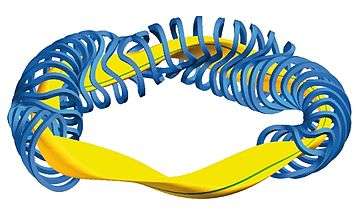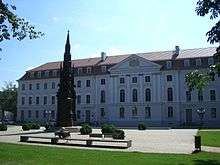Wendelstein 7-X
 | |
| Type | Stellarator |
|---|---|
| Major radius | 5.5 m |
| Minor Radius | 0.53 m |
| Plasma volume | 30 m3 |
| Magnetic field | 3 T |
| Heating | 14 MW |
| Location | Greifswald, Germany |





The Wendelstein 7-X (W7-X) reactor is an experimental stellarator (nuclear fusion reactor) built in Greifswald, Germany, by the Max Planck Institute of Plasma Physics (IPP), and completed in October 2015.[2] It is a further development of Wendelstein 7-AS. The purpose of Wendelstein 7-X is to evaluate the main components of a future fusion reactor built using stellarator technology, although Wendelstein 7-X itself is not an economical fusion power plant.
As of 2015 the Wendelstein 7-X reactor was the largest stellarator device. It is planned to operate with up to 30 minutes of continuous plasma discharge, demonstrating an essential feature of a future power plant: continuous operation.
The name of the project, referring to the mountain Wendelstein in Bavaria, was decided at the end of the 1950s, referencing the preceding project from Princeton University under the name Project Matterhorn.[3]
The research facility is an independent partner project with the University of Greifswald.
The stellarator was conceived by physicist Lyman Spitzer.
Design and main components
The Wendelstein 7-X device is based on a five field-period Helias configuration. It is mainly a toroid, consisting of 50 non-planar and 20 planar superconducting magnetic coils, 3.5 m high, which induce a magnetic field that prevents the plasma from colliding with the reactor walls. The 50 non-planar coils are used for adjusting the magnetic field. It aims for a plasma density of 3×1020 particles/cubic metre, and a plasma temperature of 60–130 million K.[1]
The main components are the magnetic coils, cryostat, plasma vessel, divertor and heating systems.[4]
The coils (NbTi in aluminium[4]) are arranged around a heat insulating cladding with a diameter of 16 meters, called the cryostat. A cooling device produces enough liquid helium to cool down the magnets and their enclosure (about 425 metric tons of 'cold mass') to superconductivity temperature (4 K[5]). The coils will carry 12.8 kA current and create a field of up to 3 Tesla.[5]
The plasma vessel, built of 20 parts, is on the inside, adjusted to the complex shape of the magnetic field. It has 254 ports (holes) for plasma heating and observation diagnostics. The whole plant is built of five almost identical modules, which were assembled in the experiment hall.[4]
The heating system[6] includes 10 megawatts of microwaves for Electron Cyclotron Resonance Heating (ECRH), for up to 10 seconds, and can deliver 1 megawatt for 50 seconds during operational phase 1 (OP-1).[7] For operational phase 2 (OP-2), after completion of the full armor/water-cooling, up to 8 megawatts of neutral beam injection will also be available for 10 seconds,[8] while the microwave system will be extended to true steady state (30 minutes). An Ion Cyclotron Resonance Heating (ICRH) system will become available for physics operation in OP1.2.[9]
A system of sensors and probes based on a variety of complementary technologies will measure key properties of the plasma, including the profiles of the electron density and of the electron and ion temperature, as well as the profiles of important plasma impurities and of the radial electric field resulting from electron and ion particle transport.[10]
History
The German funding arrangement for the project was negotiated in 1994, establishing the Greifswald Branch Institute of the IPP in the north-eastern corner of the recently integrated East Germany. Its new building was completed in 2000. Construction of the stellarator was originally expected to reach completion in 2006. Assembly began in April 2005. Problems with the coils took about 3 years to fix.[4] The schedule slipped into late 2015.[4][11][12]
A three-lab American consortium (Princeton, Oak Ridge, and Los Alamos) became a partner in the project, paying $7.5 million USD of the eventual total cost of 1.06 billion Euros.[13] In 2012, Princeton University and the Max Planck Society announced a new joint research center in plasma physics,[14] to include research on W7-X.
The end of the construction phase (which consumed more than 1 million assembly hours[15]) was officially marked by an inauguration ceremony on 20 May 2014.[16] After a period of vessel leak-checking, beginning in the summer of 2014, the cryostat was evacuated, and magnet testing was completed in July 2015.[5]
The reactor successfully produced helium plasma (with temperatures of about 1×106 K) for about 0.1 s on December 10, 2015. For this initial test with about 1 mg of helium gas injected into the evacuated plasma vessel, microwave heating was applied for a short 1.3 MW pulse.[17]
More than 300 discharges with helium were done in December and January with gradually increasing temperatures finally reaching six million degrees Celsius, to clean the vacuum vessel walls and test the plasma diagnostic systems. Then on February 3, 2016, operational phase 1 (OP-1) began, with production of the first hydrogen plasma to initiate the science program. The highest temperature plasmas were produced by four megawatt microwave heater pulses lasting one second: Plasma electron temperatures reached 1×108 K, while ion temperatures reached 1×107 K. More than 2,000 pulses were conducted before shutdown.[18]
Such tests were planned to continue for about a month, followed by a scheduled shut-down to open the vacuum vessel and line it with protective carbon tiles and install a "divertor" for removing impurities and heat from the plasma. Then the science program will continue while gradually increasing discharge power and duration.[19]
Timeline
| Year | Event |
|---|---|
| 1994 | Project initiated |
| 2005 | Assembly began |
| 2014 | Inaugurated |
| 2015 | Successful helium plasma test at 1×106 K for ~0.1 s |
| 2016 | Hydrogen plasma at 80×106 K for 0.25 s |
Financing
Financial support for the project is about 80% from Germany and about 20% from the European Union. 90% of German funding comes from the federal government and 10% from the state government of Mecklenburg-Vorpommern. The total investment for the stellarator itself over 1997–2014 amounted to 370 million euros, while the total cost for the IPP site in Greifswald including investment plus operating costs (personnel and material resources) amounted to EUR 1.06 billion for that 18-year period. This exceeded the original budget estimate, mainly because the initial development phase was longer than expected, doubling the personnel costs.[20]
In July 2011, the President of the Max Planck Society, Peter Gruss, announced that the United States would contribute 7.5 million dollars under the program "Innovative Approaches to Fusion" of the US Department of Energy.[21]
Collaborating institutes
Germany
- Technical University of Berlin
- University of Greifswald
- Forschungszentrum Jülich
- Karlsruhe Institute of Technology
- Institut für Grenzflächenverfahrenstechnik und Plasmatechnologie (IGVP) at the University of Stuttgart
- Physikalisch-Technische Bundesanstalt
Europe
- Commissariat à l'énergie atomique et aux énergies alternatives (CEA; France)
- Centro de Investigaciones Energéticas, Medioambientales y Tecnológicas (CIEMAT; Spain)
- Institute of Nuclear Physics Kraków and National Centre for Nuclear Research (Poland)
- Institute of Plasma Physics and Laser Microfusion, Warsaw (Poland)
- KFKI Research Institute for Particle and Nuclear Physics of the Hungarian Academy of Sciences (Hungary)
- Trilateral Euregio Cluster (Germany/Belgium/Netherlands)
United States
- Los Alamos National Laboratory
- Oak Ridge National Laboratory
- Princeton Plasma Physics Laboratory
- University of Wisconsin–Madison
- Massachusetts Institute of Technology
Japan
See also
- Similar stellarators:
- Large Helical Device, Japan, Heliotron, superconducting, 1998-
- Helically Symmetric Experiment, USA, Quasi-Helically Symmetric
- National Compact Stellarator Experiment, three field-period Helias configuration - Had similar coil problems - construction halted in 2008
References
- 1 2 Introduction – the Wendelstein 7-X stellarator Retrieved 2014-11-5.
- ↑ Clery, Daniel. "The bizarre reactor that might save nuclear fusion". sciencemag.org. Science Magazine. Retrieved 25 October 2015.
- ↑ WI-A, WI-B, WII-A, WII-B, W7-A: G. Grieger; H. Renner; H. Wobig (1985), "Wendelstein stellarators" (in German), Nuclear Fusion 25 (9): pp. 1231, doi:10.1088/0029-5515/25/9/040
- 1 2 3 4 5 Klinger, Thomas (2011-04-14). "Stellarators difficult to build? The construction of Wendelstein 7-X" (PDF). Retrieved 2011-06-13. 53 slides - many photos
- 1 2 3 "Magnet tests on Wendelstein 7-X successfully completed". 2015-07-07.
- ↑ "Stellarator Heating and Optimization". Retrieved 10 December 2015.
- ↑ "Microwave heating - ECRH". Retrieved 10 December 2015.
- ↑ "Neutral Beam Injection Heating (NBI)". Retrieved 10 December 2015.
- ↑ "Ion Cyclotron Resonance Heating (ICRH)". Retrieved 10 December 2015.
- ↑ "Profile Diagnostics". Retrieved 10 December 2015.
- ↑ Arnoux, Robert (2011-04-15). "The stellarator renaissance". Retrieved 2011-06-13.
- ↑ Jeffrey, Colin (October 25, 2015). "Wendelstein 7-x stellarator puts new twist on nuclear fusion power". www.gizmag.com. Retrieved 2015-10-27.
- ↑ "US narrows fusion research focus, joins German stellarator". 2011-09-01.
- ↑ "Princeton, Max Planck Society launch new research center plasma physics". 2012-03-29.
- ↑ "Start of scientific experimentation at the Wendelstein 7-X fusion device". phys.org. June 7, 2016. Retrieved 2016-10-11.
- ↑ Milch, Isabella (2014-05-12). "Preparations for operation of Wendelstein 7-X starting". Retrieved 2014-05-16.
- ↑ "The first plasma: the Wendelstein 7-X fusion device is now in operation". Max Planck Institute for Plasma Physics. 10 December 2015. Retrieved 10 December 2015.
- ↑ "Wendelstein 7-X: Upgrading after successful first round of experiments". phys.org. July 11, 2016. Retrieved 2016-10-11.
- ↑ "Wendelstein 7-X fusion device produces its first hydrogen plasma". Max Planck Institute for Plasma Physics. 3 February 2016. Retrieved 4 February 2016.
- ↑ FAZ: Start frei für deutschen Sonnenofen vom 20. Mai 2014
- ↑ Isabella Milch (July 7, 2011). "USA joining the Wendelstein 7-X fusion project". Max Planck Institute of Plasma Physics. Retrieved February 4, 2016.
External links
| Wikimedia Commons has media related to Wendelstein 7-X. |
Coordinates: 54°04′23″N 13°25′26″E / 54.073°N 13.424°E
